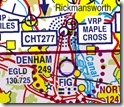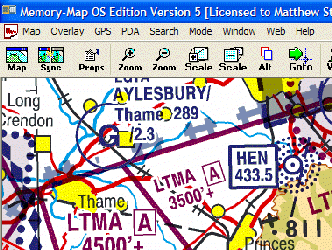
VFR flight planning can be a chore. All those chinagraph pencils and rulers. Plus your map is always in the plane when you need it at home to check something. Memory-Map reckon they have the answer: software that runs on PCs and PocketPCs that displays CAA VFR charts in all their glory. But how does it work in practice?
Installing the software is easy. Pop in a CD to install the software and then select which maps to install. Activating the maps means going to the Memory-Map website to get an activation key but it’s painless, especially compared with activating maps on other software. I got myself in a real pickle updating Garmin maps once and getting TomTom Go onto my PocketPC tooks four hours.
So far so good. Once you open the software, it’s obvious this is a program that is designed to please different users. There are demo OS maps for walkers, Admiralty charts for sailors, aerial photography and terrain elevation data for, well, people who like that sort of thing. However, these charts are restricted – the package I received only display CAA charts for the full coverage area.
Selecting CAA charts gives you a choice of the normal 1:500,000 maps or each of the four 1:250,000 charts that covers the South of England. Both display very clearly and scroll smoothly. Zoomed out they look busy and pixellated but at 100% zoom they are look looking at the real thing. The 1:250,000 charts are a revelation – the detail is incredible and I can imagine they would be a real boon for visual navigators.
I’m not sure how valuable the terrain or aerial photography data is for pilots, especially when most of this kind of information is available for free on Google Earth. But the ability to display maps side by side and the delightful way it ‘flies’ through a route in 3D could be useful for some pilots, for example helicopter pilots scouting out a new landing place.

It’s easy to draw a route onto the map. It would be helpful if the search function could find navigation beacons, VRPs and airports but they’re easy to track down visual. After all that’s what you do with a paper map.
I’m slightly nervous that you would have to buy a new version of the software each time the charts were reissued if you planned to use this as your main planning tool. An update costs £49.95 which is a good deal compared to the price of all the different chart variants but if you’re accustomed buying just the 1:500,000 charts it’s a bit of a price rise.
Airfield charts drawn from the AIP are an added bonus. You can also download the application and map data to a PDA or Smartphone (it worked very well on my iPAQ and Orange C600 phone). This is a neat trick and could be useful in some circumstances, especially if your PocketPC had a GPS receiver. Oddly, though, although my iPAQ does have one built-in, it is not supported by the software, at least as far as I could see.
Although Memory-Map sells waterproof A4 paper and it’s possible to print out maps, I suspect that this product is most useful for people with PocketPCs and GPS devices who might use it as a kind of moving map and upload tracks after the flight to evaluate their performance. For this, I think it would be very useful. Most of all, Memory-Map points the way to a world of paper free cockpits and planning.